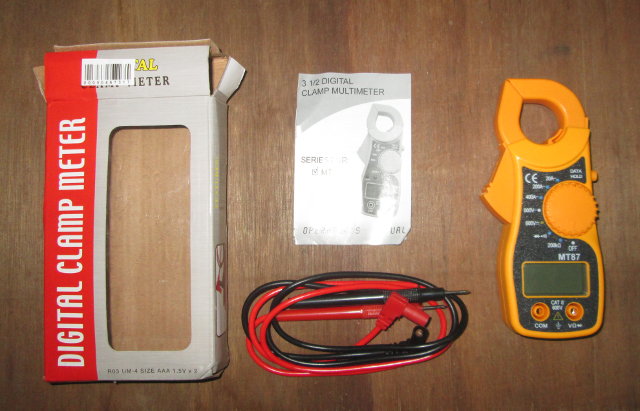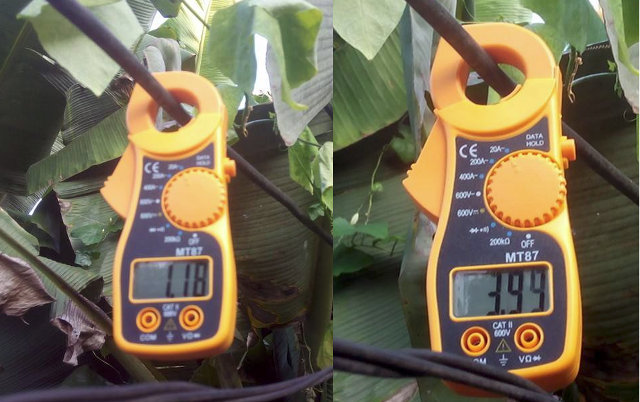When you want to measure power/current on electrical device, a kill-a-watt is the easiest method, but it’s not always possible for items like air conditioner, water pumps, etc… because they may simply be no plug to disconnect. Luckily, current clamps are made just for this purpose, where you simply place one of the two wires in a clamp / loop, and it magically measures the current. You can’t put both wires inside the loop or measurement will not work at all. The good news is that such devices are very inexpensive, and I bought MT87 digital clamp multimeter, which is also a multimeter adding voltage and resistance measurement capability, for just $11.33 on DealExtreme.
 MT87 comes with measurement leads (voltage/resistance only), and a user’s manual. The linked user’s manual is not exactly the same document, but very similar, and also refers to MT87C model which adds temperature measurement.
MT87 comes with measurement leads (voltage/resistance only), and a user’s manual. The linked user’s manual is not exactly the same document, but very similar, and also refers to MT87C model which adds temperature measurement.
There are three ranges for alternative current (20A, 200A and 400A), 600V ranges for alternative and continuous voltages, a 200 kOhm range with 100k resolution, and a diode and continuity option with buzzer. So it’s pretty much for heavy duty measurements, and not useful for low power devices, but it’s not what it’s for. The button of the right on the device is used to hold data, so if it’s in location you can’t read the display during measurement, you can press the button, take out the clamp and read the measurement.
I haven’t tried the voltage and resistance measurement. After inserting two AAA battery in the device, the first challenge was to find an electric appliance with the two cables already separated, since I did not want to use a cutter on the power cords of my appliances. First I found I could do that with my water pump, measuring around 2A @ 230V, so 460W. But them I realize the cables from the street to my house were easily accessible, and properly insulated, so I should be able to measure the full power consumption of my house, but simply clamping the device to one of the cables.
 And I did get measurements which are consistent with the results I got for my computer and fridge using my now defunct kill-a-watt clone:
And I did get measurements which are consistent with the results I got for my computer and fridge using my now defunct kill-a-watt clone:
- Computer only – 0.74 to 0.80 A (~ 180 Watts)
- Computer + fridge – 1.18 A (~ 270 Watts)
- Computer + 9,500 BTU aircon – 3.99 A (~ 920 Watts)
So based on these few results, it works nicely, and it can be a useful and affordable tool to evaluate how much power your household appliances consume.

Jean-Luc started CNX Software in 2010 as a part-time endeavor, before quitting his job as a software engineering manager, and starting to write daily news, and reviews full time later in 2011.
Support CNX Software! Donate via cryptocurrencies, become a Patron on Patreon, or purchase goods on Amazon or Aliexpress




